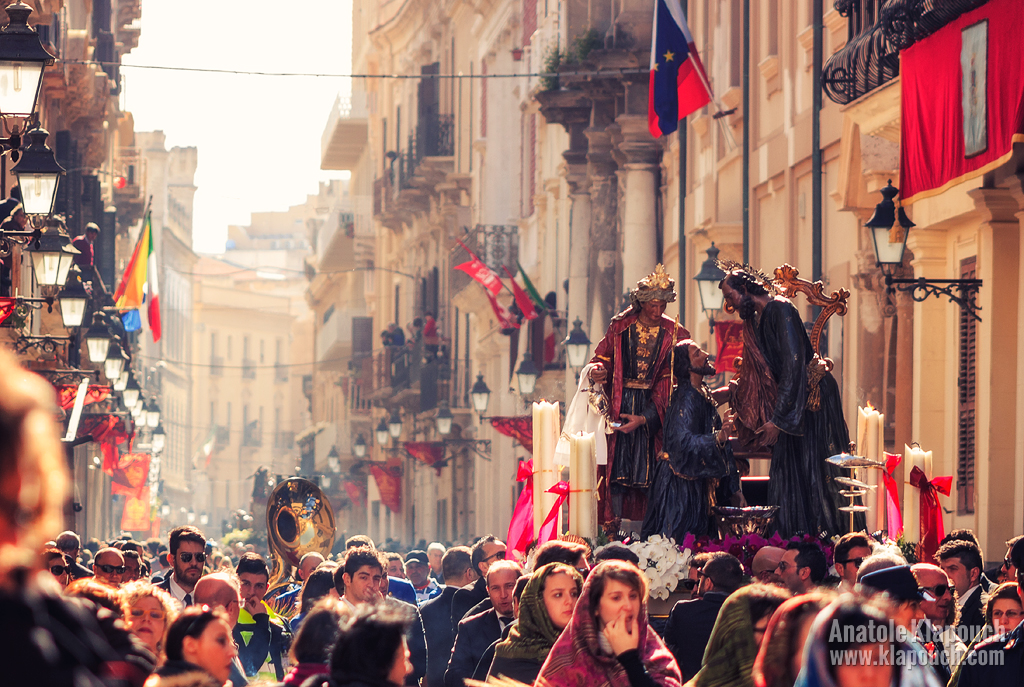Processione dei Misteri di Trapani
La processione dei misteri si svolge a Trapani il Venerdì Santo, da 400 anni.
La processione composta da 20 gruppi sacri, ha inizio alle 14 del venerdì santo, per concludersi ventiquattro ore dopo. Viene considerata la più lunga manifestazione religiosa italiana dopo la Sagra di sant'Efisio che dura ben 4 giorni, e soprattutto una tra le più antiche. La processione che parte dalla Chiesa delle Anime del Purgatorio, percorre le principali vie cittadine.
I Misteri sono la rappresentazione artistica della morte e passione di Cristo, in totale sono 20 gruppi sacri, di cui due simulacri di Gesù Morto e di Maria Addolorata. Furono concessi in affidamento, tramite atti notarili, dalla Confraternita di San Michele Arcangelo che istituì il rito alle maestranze locali con l'impegno di curarne l'uscita in processione.
La tecnica di realizzazione delle statue, iniziata da Giovanni Matera, consiste nello scolpire nel legno i volti, le mani ed i piedi, così come di legno è lo scheletro. Sono internamente sostenuti da ossature in sughero, sui quali si modellavano gli abiti grazie al fatto che la stoffa, precedentemente immersa in una mistura di colla e gesso, permetteva una maggiore naturalezza degli abiti e, maggiore plasticità espressiva, secondo una tecnica tipicamente trapanese, detta carchèt. In tal modo nei drappeggi dei vestiti vennero realizzate quelle pieghe che si plasmavano alla diversità della scena rappresentata e rendevano ogni figura diversa dall'altra.
Per la realizzazione di questi gruppi non ci si ispirò all'iconografia classica, ma ad episodi citati nei sacri testi o nei vangeli apocrifi ed aggiungendo anche delle personali interpretazioni, e gli artisti trapanesi seppero dare a questi gruppi una dinamicità rappresentativa unica nel vasto panorama delle sacre rappresentazioni.
Le statue sono fissate ad una base lignea detta vara, con un procedimento particolare, al fine di consentire una certa oscillazione durante il trasporto, tale da esprimere una scenica rappresentatività al gruppo.
The Processione dei Misteri di Trapani or simply the Misteri di Trapani (in English the Procession of the Mysteries of Trapani or the Mysteries of Trapani) is a day long passion procession featuring twenty floats of lifelike wood, canvas and glue sculptures of individual scenes of the events of the Passion, a passion play at the centre and the culmination of the Holy Week in Trapani. The Misteri are amongst the oldest continuously running religious events in Europe, having been played every Good Friday since before the Easter of 1612, and running for at least 16 continuous hours, but occasionally well beyond the 24 hours, are the longest religious festival in Sicily and in Italy.
In the late middle age and early renaissance the phenomenon of the Passion plays had spread in most Catholic countries. Passion plays, also when springing from a sincere religious devotion, were anyway occasionally mutating in farces, a trend which became more widespread in the early 16th century, to the obvious discomfiture of the Catholic hierarchies, who then started to oppose them.
In the late 16th century, religious authorities but also lay authorities ended up to forbid or anyway to strongly limit passion plays in various place around Europe, meanwhile in certain areas, like in parts of the then sprawling Spanish Empire, these started to be substituted by processions of figurative art depicting the various episodes of the Passion of Jesus.
Just like the procession of the pasos in Seville, or the procession of the vare in Caltanissetta or in many similar processions in various parts of the contemporary Spanish Empire, in Trapani at some point during the Counter-Reformation the episodes of the passion of Jesus started to be narrated through sculptural groups who were created from local artists.
As the most famous contemporary historian of the story of the city of Trapani, Francesco Pugnatore, does not mention the existence of the Misteri in its magnum opus, the much detailed 'Historia di Trapani' published in 1594, we can reasonably presume that the procession of the Misteri was not held before at least the latter part of the 16th century. As the Fellowship of the Precious Blood of Christ and of the Mysteries (in Latin Societas Pretiosissimi Sanguinis Christi et Misteriorum), one of the two religious societies which were managing the procession of the Misteri in the early to middle 17th century, was founded by in 1603, and the procession is explicitly referred on a document notarized the 20 April 1612, the deed of trust on which the Guild of the Journeymen was granted the caretaking of the group representing the Ascent to Calvary, we can also reasonably assume that the procession of the Misteri was surely held before the Easter of 1612.
The 'Misteri' are an artistic representation of the Passion and Death of Jesus through twenty sculptural groups, including two statues of the Dead Jesus and of the Lady of Sorrows. They were granted in trust, by deeds, by the Brotherhood of St. Michael the Archangel, which instituted the rite in the late 16th century, to the members of the local Guilds in exchange of the promise to carry them during the passion procession every Good Friday.
Fonte: Wikipedia
Guardate le nostre offerte per Pasqua in fondo alla pagina e contattateci per info e prenotazioni.
Look at our offers for Easter holiday at the end of the page and contact us for info and booking.




Nessun commento:
Posta un commento